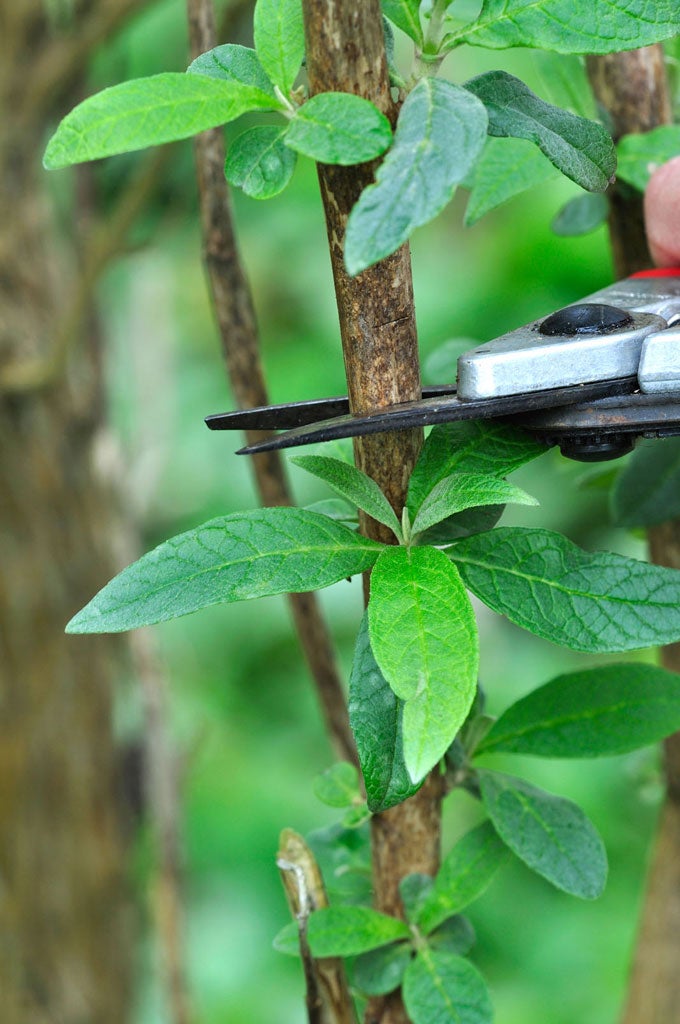The Independent's journalism is supported by our readers. When you purchase through links on our site, we may earn commission.
Cutbacks, cutbacks: It's time to cut loose with the pruning shears

And how am I going to reach that?" my neighbour guffaws. We are looking up at a stray tendril, hovering temptingly between the ground and first floor, just out of reach. The rain has made everything grow so ridiculously, fairy-tale-beanstalk-tall this year. Stems have grown long and wandering, leaves are plate-sized. Sometimes that's a good thing, but lately it can feel as though the main result has been an eye-watering quantity of pruning and weeding.
And so a joint work-group for our front gardens has taken at least two hours to remove just a fraction of the summer's growth so far. And led us to conclude that neither of us is tall enough to grab that last elusive tendril. A stepladder sinks into the moist soil and the fence is not really sturdy enough to climb on; so we just stand here and ponder.
This afternoon has been a lesson in summer pruning. First the buddleia, which looms large in August, blocking out light but still bearing a few purple cones. Most people don't prune buddleia properly, mainly because they are generally self-seeded weeds. But if you do prune, you'll get much more flower power per stem.
There's no need to be afraid – you really can cut this plant back fiercely. But not just yet. If the bush is too big right now, cut back the most inconvenient stems as soon as they've finished flowering. Then, in November, cut it all back by about half, and then in early spring (March-ish, before it warms up), take the whole bush back to 50cm stems. This can be hard work – buddleias often have big trunks after a few years. But it's worth the effort in thick flowers and much neater growth for next year.
Next we move on to the roses. Roses are more complicated, because there are specialised rules for different types. But a few rules apply to all: the first is taking out older stems that aren't flowering and shooting well. (Ascertain that now, even if you actually prune later.) Second, you need to cut near a bud. Really close, in fact, so that the plant can get on and grow afterwards.
Finally, pick the right time: our neighbourhood roses weren't pruned properly this year, so there are a few long, spindly stems which we are cutting now, but for the most part, roses should be cut back during the winter and spring after they have stopped growing. The main summer job is to neaten up the shape of the plant and remove those outsize stems and dead flowers. Job now done.
Finally, we come to a normally very pretty hydrangea, which should now be in flower. Unluckily for this cutie, it got chopped right at the wrong moment in 2012. Hydrangeas produce their flowers on stems which grew in the previous year, and this one got heavily cut back in spring by a gardener not apprised of that information. So, yes, chop off the previous year's flowerheads when spring comes, but don't cut the new green stems below or you risk a flowerless summer.
It might be concluded that even a light summer pruning is a complicated business. The rules for each plant can seem confusing and even contradictory. But do it once and the process seems to get engraved on your memory and is easier to summon up for next time. And though there are rules, it is OK once in a while to break them, especially when plants seem to have acquired magical pumpkin properties of growth.
And so I and my neighbour go on working – we just have to figure out how to snip that impossible floating shoot.
PRUNING FOR BEGINNERS
Keep it clean
Clean, sharp secateurs please, if only to avoid aching wrists. Wash in soapy water. Then, when dry, oil and sharpen. The Draper 76765 is a cool little gadget. £5.50, amazon.co.uk
Stamp duty
Look after the labels. There's nothing more irritating than spending 20 minutes trying to work out which clematis group your plant belongs to before you can chop it. Or write it down in an RHS Notebook. £9.10, amazon.co.uk
Ask the experts
The RHS website has extensive pruning advice for almost every plant under the sun. RHS members have additional help in the form of the Members' Advisory Service's experts, an email away. Membership: £38.25 annually, rhs.org.uk
Subscribe to Independent Premium to bookmark this article
Want to bookmark your favourite articles and stories to read or reference later? Start your Independent Premium subscription today.

Join our commenting forum
Join thought-provoking conversations, follow other Independent readers and see their replies